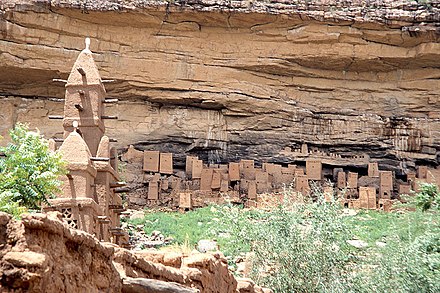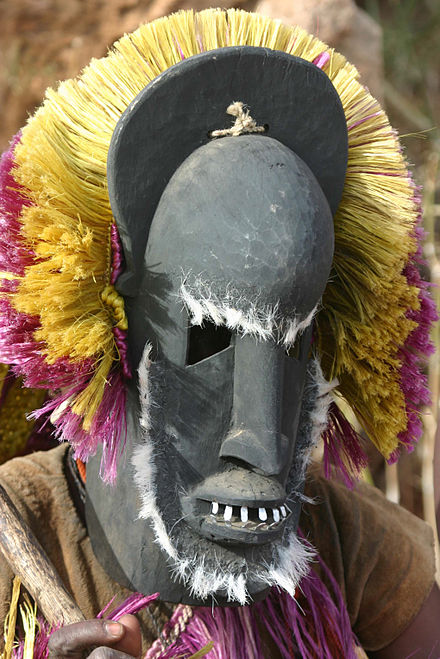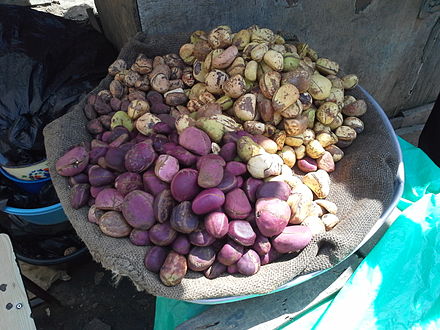Dogon Country

Dogon Country (French: Pays Dogon) is the name used for a region of south-central Mali renowned for its secluded villages embedded on cliffs that are up to 500 m tall which were inscribed as an UNESCO World Heritage Site in 1989. These are near the city of Bandiagara.
The Dogon people have been living in this area for 1,000 years following their refusal to be converted forcibly to Islam. This then led to the development of their own religion, culture, and language. Most visitors to Dogon Country will start in one of the major towns such as Bandiagara and trek to smaller villages.
Villages
The main reason to take on the expense and time of going to Dogon Country is to hike the many small villages that exist there, perched either up on the plateau or down in the sandy lowland. Below are the villages that are most commonly visited.
Southern Plateau
- Begnimato - Housing is available.
- Dourou - On the top of the plateau and a trail head to villages such as Nombori. Also a good place to buy the indigo fabrics on market day, although haggling will be tough. Housing is available.

- Songo - Very accessible from the main road and has luscious paintings on a cliff where they perform traditional male circumcisions. Officially, women aren't allowed in the place, but foreign women are as long as they aren't of African descent. A local guide costs 3,000 CFA. Housing is available.
Northern Plateau
- Bamba - Housing is available.
- Kassa - Housing is available.
- Koundou - Housing is available.
- Sanga - A common trail head to the Youga villages as well as several more. Housing is available.
- Yendouma - Housing is available.
- Youga - Actually a series of three villages on a loop in the northern area that are best approach from Sanga or driving close to them via 4x4. Housing is available.
Lowland
- Amani - No housing.
- Banani - Housing is available.
- Endé - Housing is available.
- Guimini - No housing.
- Ibi - No housing.
- Idjeli-na - An additional walk of about 4-km round trip from Nombori and also a very picturesque village in the area. Recommended for those who make it early enough to Nombori to complete the trip in a day or who plan to stay overnight. No housing.
- Ireli - Housing is available.
- Kani-Kombolé - Housing is available.
- Komokani - No housing.
- Nombori - With a staggering approach through a gorge on the cliff above, Nombori is an excellent hike in for those looking to make just a day trip and see a typical village of the area that has old Telem homes in the rocks above the village. A local guide costs 3,000 CFA and is really necessary as it is quite easy to stumble in to an area that the people hold sacred. Approximately 10-km round trip hike from Dourou and it is recommend to hire a local kid for 3,000 CFA to lead you down there as while the trail is good, it is easy to get lost at various points and the scramble down the cliff is arduous. Housing is available.
- Ourou - No housing.
- Teli - Housing is available.
- Tireli - Housing is available.
- Yaba-Talu - Housing is available.
- Yawa - Housing is available.
- Yaye - No housing.
Understand
Dogon Country's villages lie among the plains, and especially the cliffs along the Bandiagara Escarpment. For obvious reasons, it's rather difficult to reach the steep cliffside villages, where the Dogons have lived to protect themselves from potentially hostile neighbors, as well as wild animals. Today, the vast majority of the population lives in the plains below the escarpment in more recently constructed villages, but the old homes remain, and are taken care of and in excellent shape.

The Guide to guides
From the moment you step off the bus, open your car door, sit down in a restaurant, or have a stretch outside your hotel, you will most likely have someone offering to be your guide through Dogon Country. They can be quite insistent, annoying, and act to be offended if you yell at them to go away. Some travelers have mused that the sole purpose of hiring a guide is merely to chase off other would-be guides.
Do you actually need a guide? Numerous guidebooks will tell you that you do, while some allude to the fact that actually you don't. The guides in Dogon will almost always tell you that you do and there are even some signs telling you that entry to the village is prohibited without a guide. The truth of the matter is that really, you aren't required to have a guide. There are some caveats to this:
- Language - If you don't speak French, you will indeed have to have a guide as there are very few people in the villages that speak that many extra languages, although English is gaining ground on French.
- Hassle - Traveling without a guide is indeed more difficult as you have to negotiate everything yourself and for those who don't enjoy haggling or have the time to do this, a guide makes things easier.
- Respect - Guides are useful in stopping you from making a mistake or walking somewhere you shouldn't in the villages, which can incur a fine for sacrificing an animal to purify the grounds you have defiled. Of course, you don't need a guide from Bandiagara or Mopti to help you with this and hiring someone locally for 3,000 CFA upon arrival will work fine.
If you do decide to use a guide, how much should he (they are always men) cost? Again, guidebooks will generally quote the amount at around 10,000-15,000 CFA per person, per day, which gets quite costly quite fast and explains why so many people are trying to act as guides given that most people in Mali earn about 1,000 CFA a day. Most will ask for a great deal more than this amount initially and you will absolutely have to haggle him down. Due to the incredible amounts of money spent by various travelers to Dogon Country, some will even start out their prices at 50,000 CFA per person, per day.
The price you pay can include any variety of things, but it should absolutely include visiting 2-3 villages per day, the tax for those villages, and meals. It will not include drinks (which are quite expensive in Dogon Country) or transportation. If you can, insist on writing up a contract prior to leaving so that there is no changing of plans during the trip. Proper agencies, while more expensive should always print a contract as well as require the money upfront.
If you opt to hire a local guide upon arrival to the villages, they will generally charge about 3,000 CFA for everyone as well as the village tax (generally from 1,000-3,000 CFA.) For those wishing to save money, directly support those who choose to stay in their villages to carry on the traditions, as well as discourage the guide industry seen in larger towns, this is a good balance of options. For those wishing to have someone lead them on a hike (ex. from Dourou to Nombori), a local can be hired for 3,000 CFA to walk you down. Again, it directly supports the local people and works well for those willing to adventure a little.
Talk
The local Dogon language is spoken by everyone, but due to its popularity with tourists French remains the lingua franca. English is spoken by only a handful of tour guides in the entire region and practically no one outside the handful of cosmopolitan (relatively speaking) base camps/towns. A working knowledge of French is essential unless travelling with one of the few guides who speak English.
Get in
Unfortunately you have to hire some kind of car to get in to the heart of Dogon, whether you rent it with or without a driver. With a driver, cars in Mopti will generally costs 50,000 CFA per day plus gas. You might be able to haggle them down to 25,000 if you're going to rent it multiple days or it is the low season, but it will be money hard-won. Drivers are difficult as they generally don't like to drive and if you want to visit three villages in a day, most will get grumpy, which means you will have to be firm and emphasize your plan.
Bandiagara, Bankass, Douentza are the three main town entry points in to Dogon and places where you can find a never ending supply of harassing guides as well as supplies for the trip, although they will cost a great deal more than in a town such as Mopti.
For those who will make the hike down in the villages, the most common starting point are the larger villages of: Kani-Kombolé, Djiguibombo, Endé, Dourou, and Sanga.
Get around
There are almost no roads in the region, except those connecting a couple of towns used as base camps with the neighboring regions. You will need to go on foot and be in relatively good shape. A number of the hikes are quite strenuous, although you'll see village women trekking up them with piles of goods on their heads. Despite the fact that the Dogon people walk these trails in sandals, it is advisable for anyone visiting to wear either a sturdy pair of running shoes or hiking boots depending upon your needs.
See
There are hundreds of unique towns scattered throughout the region and while all are unique and, while there is no "typical" Dogon village, most can be found built into the sides of hills and escarpments.
Itineraries
People generally plan any number of approaches to Dogon Country. Most common is to spend about three days which allows one to visit several villages, stay in them (amenities are generally rather comfortable all things considered) and then get out. Day trips are also quite doable to a number of villages, such as Nombori. Villages like Songo can be visited in a morning.
There is also the opportunity to spend a week or more hiking the entire escarpment. This is recommended only for the truly adventurous who want to take the time to plan out the trip and be prepared to buy supplies en route.
Do

- Villages - Whether you enter with a one or many day trip, it is well-worth the journey. See the top of this article for a more detailed listing.
- Kola Nuts - Buy them in a town such as Bandiagara and give them to people such as the village chiefs or elders. While seemingly a minor detail, they are inherited from a very old tradition and are much appreciated. Plus, they allow visitors to interact in more authentic manner with people than just handing out money.
Buy
Sadly, many (but not all) of the villages have learned the value of tourism and while the culture remains strong and the villages remain spectacular, expect to pay for everything from entering each village to photographing anything inside villages to meeting certain people (i.e. chiefs). Most villages will sell arts and crafts to tourists.
Eat
Towns will generally sell small quantities of food to tourists, but there are no restaurants outside the couple of major base towns. You will likely be sharing a meal with a family. You should bring food with you to eat, although there is food to be had in the more recent small guest-houses, where they will feed you sauce (occasionally meat sauce) over rice, noodles, or couscous. It's simple, but quite tasty and cheap.
Water is a scarce commodity (do not expect to use water for bathing or hand washing) and you should bring some with you, especially to prevent dehydration while trekking between villages.
- Chez Potasse, Nombori (Walk in to the center and ask), +223 656 88 982. Quite a decent place considering how far it is from the main towns. Very good dishes and drinks cooled by dunking them in the well.

Drink
There is no alcohol to be found outside of the couple of base towns, where you'll find beer, coke, and bottled water for about 1,000CFA. It is more cost effective to stock up on supplies in a town such as Mopti where you will find a greater selection and better, albeit still high prices. Inside Dogon Country, a 1.5 liter bottle of the Malian Diago brand of water will costs around 1,250 CFA, although it is often the case that they will lower it if you buy more.
Respect
Dogons are very spiritual and visitors should be very keen to respect their beliefs. One should always ask if it is appropriate to photograph something. Altars may look like piles of dirt to the untrained eye and religious buildings may look like just a house, both of which (along with people, unless you ask permission) should not be photographed.
Stay safe
If trekking, you should be in good physical shape and carry and drink lots of water to prevent dehydration. Head covering is also recommended as the midday sun is exceedingly strong and can even catch a well-hydrated traveler offguard. Good, sturdy shoes, whether general running/walking type or hiking boots are recommended for the treks as the terrain can be difficult to traverse on some of them.
Many people find walking poles to be helping for the flatter parts of the trip, but in general, they are a hindrance, especially when navigating steep areas. Use your own judgment when carrying them, but they will be deadweight and awkward if you find you don't need them.
Lastly, be careful of snakes in brush (although most are nocturnal).
Go next
- Mopti - It is the nearest large town with all the supplies people could need as well as good connections back to Bamako.
Dogon Country
Timezone:MultipleCoordinates:14.35, -3.62